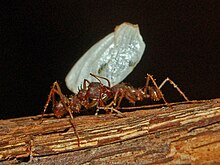| Attini | |
|---|---|

| |
| Atta mexicana workers carrying a leaf section | |
| Scientific classification | |
| Domain: | Eukaryota |
| Kingdom: | Animalia |
| Phylum: | Arthropoda |
| Class: | Insecta |
| Order: | Hymenoptera |
| Family: | Formicidae |
| Subfamily: | Myrmicinae |
| Tribe: | Attini Smith, 1858 |
| Type genus | |
| Atta Fabricius, 1804
| |
| Genera | |
|
See text | |
| Diversity[1] | |
| 46 genera | |
Fungus-growing ants (tribe Attini) comprise all the known fungus-growing ant species participating in ant–fungus mutualism. They are known for cutting grasses and leaves, carrying them to their colonies' nests, and using them to grow fungus on which they later feed.
Their farming habits typically have large effects on their surrounding ecosystem. Many species farm large areas surrounding their colonies and leave walking trails that compress the soil, which can no longer grow plants. Attine colonies commonly have millions of individuals, though some species only house a few hundred.[2]
They are the sister group to the subtribe Dacetina.[3] Leafcutter ants, including Atta and Acromyrmex, make up two of the genera.[4] Their cultivars mostly come from the fungal tribe Leucocoprineae[3] of family Agaricaceae.
Attine gut microbiota is often not diverse due to their primarily monotonous diets, leaving them at a higher risk than other beings for certain illnesses. They are especially at risk of death if their colony's fungus garden is affected by disease, as it is most often the only food source used for developing larvae. Many species of ants, including several Megalomyrmex, invade fungus-growing ant colonies and either steal from and destroy these fungus gardens, or they live in the nest and take food from the species.[2]
Fungus-growing ants are only found in the Western Hemisphere. Some species stretch as far north as the pine barrens in New Jersey, USA (Trachymyrmex septentrionalis) and as far south as the cold deserts in Argentina (several species of Acromyrmex).[2] This New World ant clade is thought to have originated about 60 million years ago in the South American rainforest. This is disputed, though, as they could have possibly evolved in a drier habitat while still evolving to domesticate their crops.[3]
- ^ Cite error: The named reference
AntCatwas invoked but never defined (see the help page). - ^ a b c Hölldobler, Bert; Holldobler, Foundation Professor of Biology Bert; Wilson, Honorary Curator in Entomology and University Research Professor Emeritus Edward O.; Wilson, Edward O. (2009). The Superorganism: The Beauty, Elegance, and Strangeness of Insect Societies. W. W. Norton & Company. ISBN 9780393067040.
- ^ a b c Branstetter, M. G.; Ješovnik, A.; Sosa-Calvo, J.; Lloyd, M. W.; Faircloth, B. C.; Brady, S. G.; Schultz, T. R. (2017-04-12). "Dry habitats were crucibles of domestication in the evolution of agriculture in ants". Proceedings of the Royal Society B: Biological Sciences. 284 (1852): 20170095. doi:10.1098/rspb.2017.0095. PMC 5394666. PMID 28404776.
- ^ Weber, N.A. (1966). "Fungus-Growing Ants". Science. 153 (3736): 587–604. Bibcode:1966Sci...153..587W. doi:10.1126/science.153.3736.587. PMID 17757227. S2CID 31919824.